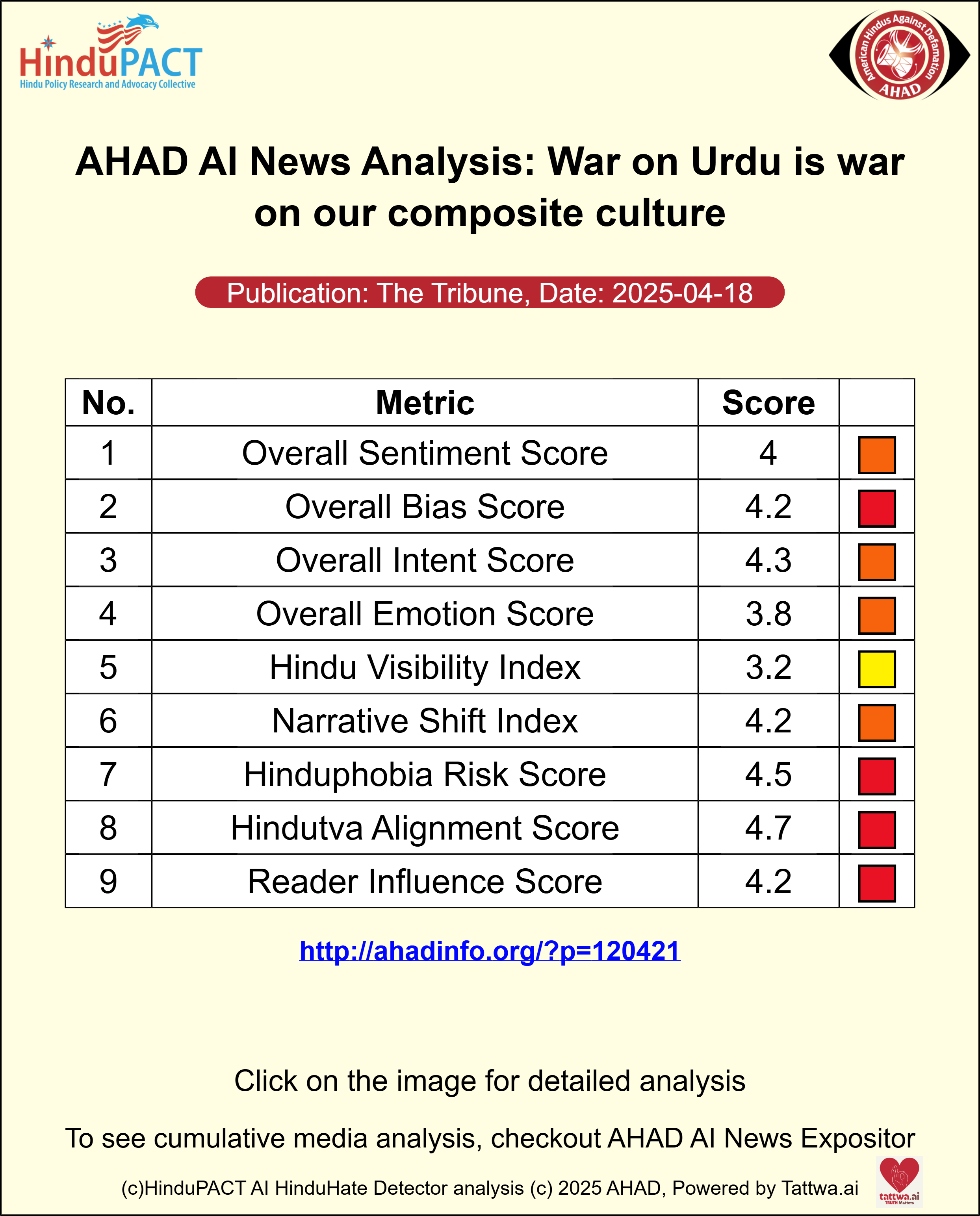Source: https://www.tribuneindia.com/news/comment/war-on-urdu-is-war-on-our-composite-culture/Date of Publication: 2025-04-18
Name of Publication: The Tribune
Abstract
In this commentary, Alok Rai argues that the perception of Urdu as a ‘foreign’ language is unfounded and stems from a broader ideological agenda. He contends that Urdu is an intrinsic part of India’s cultural and linguistic heritage, born from centuries of interaction among diverse communities. The author criticizes efforts to marginalize Urdu, suggesting they are part of a larger attempt to redefine Indian identity along exclusionary lines.
Sentiment Analysis
| Aspect | Score | Traffic Light | Explanation | Tone | Framing | Sources | Mischaracterization | Headline |
|---|
| India | 3.8 | 🟧 | Highlights internal cultural conflicts and challenges to pluralism | Critical | Emphasizes erosion of composite culture | Scholarly references | May generalize specific actions as national trends | Neutral |
| Hindu | 3.5 | 🟨 | Discusses Hindu identity in the context of linguistic politics | Analytical | Examines intersection of language and religion | Historical analysis | Avoids broad generalizations | Neutral |
| Hindutva | 4.7 | 🟥 | Strongly critiques Hindutva ideology's role in marginalizing Urdu | Derogatory | Frames Hindutva as exclusionary and divisive | Cites ideological sources | Equates Hindutva with cultural suppression | Highly Negative |
Bias Analysis
| Aspect | Score | Traffic Light | Explanation |
|---|
| Language | 4.2 | 🟥 | Employs charged terms to describe ideological movements |
| Sources | 4 | 🟧 | Relies on historical and scholarly sources aligned with the author's viewpoint |
| Representation | 4.3 | 🟥 | Focuses on negative aspects of specific ideologies without presenting counterarguments |
| Mischaracterization | 4.1 | 🟧 | Potentially conflates specific ideological stances with broader cultural trends |
| Framing bias | 4.5 | 🟥 | Frames the issue predominantly through a critical lens of Hindutva |
| Headline tone | 4 | 🟧 | Provocative headline sets a confrontational tone |
| Expert selection bias | 3.8 | 🟧 | Limited to perspectives supporting the author's thesis |
| Historical context bias | 4.2 | 🟥 | Selective historical references that support the central argument |
Intent Analysis
| Aspect | Score | Key Evidence |
|---|
| Informative | 3.5 | Provides historical context of Urdu's development |
| Persuasive | 4.6 | Aims to challenge prevailing narratives about Urdu |
| Narrative | 4.3 | Constructs a narrative linking language suppression to ideological agendas |
| Expressive | 4.2 | Expresses strong opinions against certain ideologies |
| Directive | 2.5 | Implicitly encourages reevaluation of cultural perceptions |
Emotions Analysis
| Emotion | Score | Key Evidence |
|---|
| Shock | 3.8 | Highlights surprising misconceptions about Urdu |
| Outrage | 4.5 | Strong condemnation of ideological suppression |
| Empathy | 3 | Limited expression of empathy towards affected communities |
| Hope | 2.5 | Minimal optimistic outlook |
| Fear | 3.7 | Concerns about cultural erosion |
| Neutral | 2 | Predominantly opinionated content |
Overall Scores Analysis
| Metric | Score | Std Dev | Confidence Interval | Traffic Light |
|---|
| Overall Sentiment Score | 4 | ±0.3 | 3.7 – 4.3 | 🟧 |
| Overall Bias Score | 4.2 | ±0.3 | 3.9 – 4.5 | 🟥 |
| Overall Intent Score | 4.3 | ±0.3 | 4.0 – 4.6 | 🟧 |
| Overall Emotion Score | 3.8 | ±0.3 | 3.5 – 4.1 | 🟧 |
| Hindu Visibility Index | 3.2 | ±0.2 | Moderate visibility | 🟨 |
| Narrative Shift Index | 4.2 | ±0.3 | High shift | 🟧 |
| Hinduphobia Risk Score | 4.5 | ±0.3 | 4.2 – 4.8 | 🟥 |
| Hindutva Alignment Score | 4.7 | ±0.2 | Very Low | 🟥 |
| Reader Influence Score | 4.2 | ±0.3 | High influence | 🟥 |

